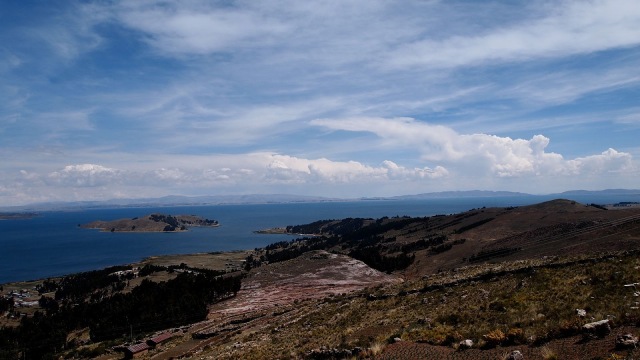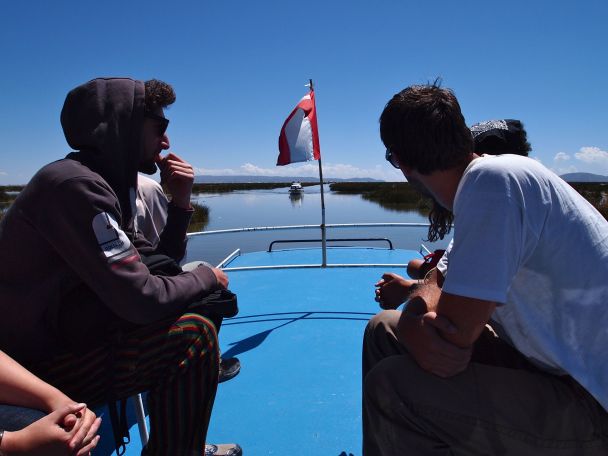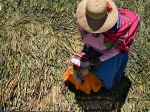Some of my travels remain in my memory because of the places I visited. And others because of the people I met along the way. Copacabana and Isla del Sol remain in my memory for both of these reasons. During these few short days, I experienced some amazing landscapes, markedly the indescribable sunsets and sunrises, as well as meeting some of the loveliest and friendliest people I have met on my travels so far.
We arrived in Copacabana, which is only a few kilometers from the Peruvian boarder, on the Bolivian side of Lake Titicaca, just in time to witness this amazing sunset pictured below (No photoshop tricks or filters here – this is what the sunset actually looked like. Amazing, huh!). Almost the entire bus load of people scrambled out to the water’s edge to take some amazing shots of what, in life looked to be an oil painting transposed onto the sky. It was truly magnificent, and like all great things, it lasted only a few short minutes, but we were fortunate enough to see it.
One of the nicest hostels we stayed in during our trip around South America was in Copacabana. We stayed in Hotel La Cupula http://www.hotelcupula.com/, (we were originally hoping to stay in the neighbouring Hostal Las Olas, but they were unfortunately booked out) and for about AU$30 for a double room, it was a steal! (This was expensive for Bolivian standards, but paying that extra $10 won’t break the budget, and you’ll get a beautifully decorated, clean room, hot showers, comfortable beds, etc). Oh, and their restaurant serves up a delicious breakfast!
We immediately fell in love with Copacabana – the easy, laid back almost bohemian atmosphere of the town, the great shopping, the fantastic restaurants, not to mention our accommodation with its view out onto Lake Titicaca. Bliss! After an evening and a morning meandering through its streets, spending too much money on jewellery, and gorging ourselves on quinoa soup, we hoped onto a boat and headed to Isla de Sol.
It was on this boat ride which we met a bunch of people with whom we’d spend the rest of our stay on the island. I remember it was Rodrigo and Marc (two university friends, one was Peruvian, the other Spanish) who broke the ice with everyone, offering around some Pisco (the national spirit of Peru, although some Chileans claim it as theirs). All the guidebooks say that when in Peru, you must drink Pisco Sours. I agree, if you want to spend your holiday nursing a hangover, as the drink is lethal. So anyway, we all managed to warm ourselves up on that icy afternoon as we made our way to Isla del Sol, with the consequence of a few of us dizzily stumbling out of the boat once we reached the shore.
Isla del Sol (The Island of the Sun) is located on the Bolivian side of Lake Titicaca, about 1 – 2 hours motor boat ride from Copacabana. There are no cars, nor paved roads on the islands, and the inhabitants of the island’s several villages living a simple life making a living from farming, fishing and now tourism. Isla del Sol is an extremely sacred place for the Incas. They believe that their creation myth, and their civilisation, began on Isla del Sol. Accordingly, they believe that the sun god was born on Isla del Sol and it is from this place that the Inca civilisation began. Some archeologist believe that the island was inhabited since the 3rd millennium BCE. There is an ancient temple, one of many archealogical ruins which are scattered around the island, which is dedicated to the sun god. We were lucky enough to have a local guide show us to this sacred site, as well as taking us to his family home, allowing us a glimpse into how the native people live on Isla del Sol.
Sunset on Isla del Sol is absolutely spectacular, in want of a better word. Many people visit the island solely to witness the sunsets and sunrises from it’s peaks. A group of about 10 of us from the hostel sat back, enjoyed a few glasses of Bolivian wine (which was the best red wine I have tasted to date! And unfortunately I’ve forgotten what it was called. We cleared out the island’s entire stock of it that night, it was that good!), and watched the sky dazzle colour for a few fleeting minutes. We continued with our wine drinking after the sun bid us good night, and managed to end up in a tiny little restaurant, ten of us all squash around a table, ordering massive giant-sized pizzas from this lovely little Aymaran man. It was such a great evening, full of chit chat, laughter, good food, good wine and great new-found friends. A few of us organised to meet at 5am the following morning, yet another early start, our trip was full of them, to watch the sunrise. And I’m so glad we got up again at the crack of dawn. You can see by the images below (which is only a few of the many, many photos I took that morning) that it was well worth the lack of sleep.
We sadly said good-bye to Isla del Sol that afternoon, to continue on our gringo trail, towards the Atacama dessert.









































































































